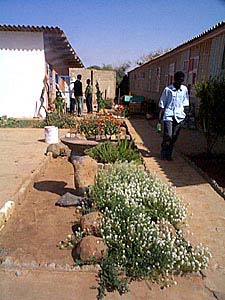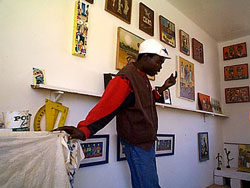The Arts Village


the studio of visual artist Assane Gning


the studio of visual artist
Pape Teigne Diouf
Pape Teigne Diouf
the studio of photographer
Djibril Sow
Djibril Sow
| The Arts Village | |||||||||||
| |back| | |||||||||||
| It was the dream of several artists that gave birth to the Arts Village, an environmental complex of 45 studios on the outskirts of Dakar. After completing their training at the Institut national supérieur des arts, these artists wanted to create a space for inter-cultural exchange and creativity. The idea was to build a small village where they could live and work within a community. Lacking financial resources, the artists decided to occupy several abandonned buildings formerly used as army barracks by the military. | |||||||||||
 | |||||||||||
 | |||||||||||
| "We were living for free," confides Moussa Tine, one of the pionneering artists. For almost six years, the village bubbled with creativity, hosting all kinds of activities: musical concerts, exhibitions, artist meetings, etc. But one fine day, the police arrived and evicted the artists. Setback! "They threw us and our bags onto the street. But we resisted and organized several sit-ins for a month," recalls Moussa Tine. The artists rallied together and organized several exhibitions and further demonstrations. | |||||||||||
the studio of visual artist Assane Gning | |||||||||||
| In 1998, during the opening of an exhibition, the President of Sénégal, Abdou Diof, declared himself the official Protector of the Arts and Literature. Not missing such an opportunity, the artists presented him with a petition advocating the return of their former premises. The President did one better: he authorized their use of an old encampment for Chinese workers who helped build the Stade de l'amité during a cooperative project between Sénégal and China in the 1990s. With the financial support of the Ministry of Culture, construction begins on the Arts Village. It was inaugerated in April, 1998. | |||||||||||
 | |||||||||||
 | |||||||||||
the studio of visual artist Pape Teigne Diouf | |||||||||||
| In addition to 45 studios, the Village in its final phase includes a gallery, a library, and several other communal spaces. The Village is managed by a mixed committee made up of government and artist representatives. The premises are free, but each of the 45 artists selected for the first three-year term must offer a work of art to the Village. Over the course of the following months, these works will be exhibited and put up for sale. The profits will go towards the operation costs of the Village. | |||||||||||
the studio of photographer Djibril Sow | |||||||||||
| Text written from information furnished by the Dakar cultural guide, Le Rapido, no.3 January, 1999. | |||||||||||